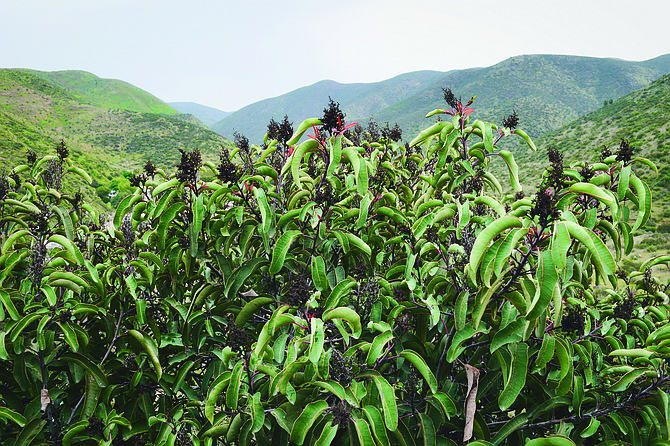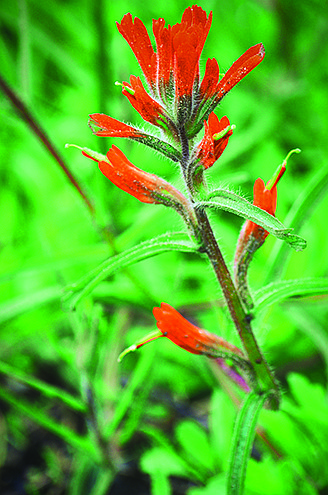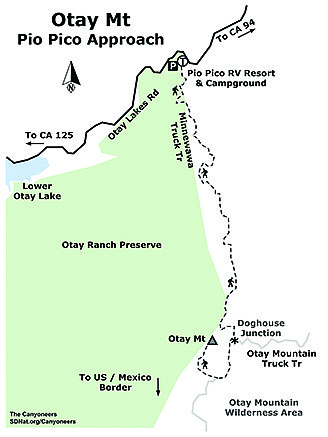 Facebook
Facebook
 X
X
 Instagram
Instagram
 TikTok
TikTok
 Youtube
Youtube

This trail features impressive summit views of surrounding mountains, the US/Mexico border, and unique plant life. It is used by hikers/walkers, trail runners, mountain bikers, and off-roading vehicles. It should be noted that this is listed as a “truck trail,” so there is a fair amount of vehicle traffic on this narrow road. The trail is steep, long, and rocky. Quite a bit of hiking needs to be done before reaching any shade. Much of the trail is winding and just wide enough for an SUV to pass. Hikers and bikers should navigate with caution. For these reasons, hiking to the summit with young children is not recommended.
This section of Otay Mountain (Pio Pico approach) is flanked, for much of the trail, by protected private land and Otay Ranch Preserve land. Indeed, much of the land directly bordering the trail is a protected sensitive habitat. So individuals using the trail must use the trail only. The sensitive habitat border is marked by signs in most areas and prohibits the following activities: off-road vehicles, biking, hiking, horseback riding, shooting, hunting, plant collecting, camping/campfires.
The route is a beautiful and challenging trail offering incredible views and rare plant species, but it can be dangerous to both hikers and vehicles. Hiking Otay Mountain alone or past sunset is not recommended. Additionally, the trail conditions vary greatly by season. During the rainy season or on a rainy day, the trail can be quite slick and rocky. Large chunks of the road can be missing. An off-road vehicle was once viewed flipped upside-down at the bottom of the mountain—a morbid symbol of caution for current and future travelers.

The hike begins from the parking area at Pio Pico Campground. Begin the hike by looking for two roads with gates just past the Pio Pico Country Store. Take the steeper uphill one with a bigger (open) gate. This is the Minnewawa Truck Road that slopes uphill just west of the neighborhood store. Minnewawa is paved for about 100 yards before turning into roughly graded dirt. Follow this road, avoiding any smaller spur roads. Near the summit is Doghouse Junction. From there, a major road does go left, but the summit is obvious to the right. In a short distance is the final quarter-mile paved spur road up to the summit. The gate may or may not be locked on this portion of the trail.
Hikers and nature enthusiasts alike are rewarded during this challenging hike to the summit of Otay Mountain, the highest summit of the San Ysidro Mountains. On a clear day, they can expect to see hundreds of miles along the San Ysidro Mountain Range, neighboring peaks, surrounding neighborhoods, San Diego’s city skyline, and Tijuana. And Otay Mountain, a remnant of an ancient chain of volancoes, supports a variety of habitats including chaparral and coastal sagebrush. White sage and chamise cover the mountainside from the start. Beautiful wildflowers fill the area in springtime. In early March, there are bursts of Indian paintbrush, California lilac, and shooting stars. Elevation gain brings about manzanita, oaks, and a unique site — Tecate cypress.
Tecate cypress, found only in southern California and Mexico, survives in a wondrous grove just past the Doghouse Junction area of the hike. This rare tree relies on fire to reproduce; however, the frequency and intensity of southern California’s present-day fires paired with habitat loss have threatened this species, making its conservation status endangered. The Quino checkerspot butterfly, a sensitive wildlife species, relies on the Tecate cypress. It lays its eggs on the flaky bark, which provides sustenance for larvae once they hatch. Other wildlife species calling Otay Mountain home include mule deer, California gnatcatchers, orange-throated whiptails, coast horned lizards, and arroyo toads.
With so many amazing things to see and appreciate, Otay Mountain is certainly worth the trek. Because it is accessible by vehicle, it is possible to shorten the walk a bit. Many hikers who wish to experience the view without a 12-mile strenuous hike may choose to drive a few miles up and park at a pull off (there aren’t many of these.) If you do choose this option, be mindful that a 4x4 is essential.
Springtime, while temperatures remain cool and wildflowers are sprinkled along the hillsides, is best for an Otay Mountain hike. Be sure to pack plenty of water and bring a camera to capture the spectacular views.

OTAY MOUNTAIN – PIO PICO APPROACH
Enjoy rarely seen expansive views on this hike
Driving directions: From Eastlake/Chula Vista, take Otay Lakes Road towards Jamul, past Lower Otay Lake, to Pio Pico RV Resort and Campground. Turn right into the campground for a small parking area (8-10 cars) and public facilities. From CA-94 east, drive past Jamul and turn right on Otay Lakes Road. Follow this road until you see the Thousand Trails Campground on the left. Also on the left will be the Pio Pico County Store. Park in the campground. (If using GPS, plug in Pio Pico Campground). Hiking length: 12.4 mile out-and-back unless you drive part of the way, but 4WD is needed on this road. Difficulty: Strenuous. Elevation change 2,893 ft. Allow 10-12 hours. No facilities. NOTE: Hiking Otay Mountain alone or past sunset is not recommended. The trail is heavily monitored by the Border Patrol as this is a popular route for illegal US/Mexico border crossing. Despite this, it is still a popular recreation route.


This trail features impressive summit views of surrounding mountains, the US/Mexico border, and unique plant life. It is used by hikers/walkers, trail runners, mountain bikers, and off-roading vehicles. It should be noted that this is listed as a “truck trail,” so there is a fair amount of vehicle traffic on this narrow road. The trail is steep, long, and rocky. Quite a bit of hiking needs to be done before reaching any shade. Much of the trail is winding and just wide enough for an SUV to pass. Hikers and bikers should navigate with caution. For these reasons, hiking to the summit with young children is not recommended.
This section of Otay Mountain (Pio Pico approach) is flanked, for much of the trail, by protected private land and Otay Ranch Preserve land. Indeed, much of the land directly bordering the trail is a protected sensitive habitat. So individuals using the trail must use the trail only. The sensitive habitat border is marked by signs in most areas and prohibits the following activities: off-road vehicles, biking, hiking, horseback riding, shooting, hunting, plant collecting, camping/campfires.
The route is a beautiful and challenging trail offering incredible views and rare plant species, but it can be dangerous to both hikers and vehicles. Hiking Otay Mountain alone or past sunset is not recommended. Additionally, the trail conditions vary greatly by season. During the rainy season or on a rainy day, the trail can be quite slick and rocky. Large chunks of the road can be missing. An off-road vehicle was once viewed flipped upside-down at the bottom of the mountain—a morbid symbol of caution for current and future travelers.

The hike begins from the parking area at Pio Pico Campground. Begin the hike by looking for two roads with gates just past the Pio Pico Country Store. Take the steeper uphill one with a bigger (open) gate. This is the Minnewawa Truck Road that slopes uphill just west of the neighborhood store. Minnewawa is paved for about 100 yards before turning into roughly graded dirt. Follow this road, avoiding any smaller spur roads. Near the summit is Doghouse Junction. From there, a major road does go left, but the summit is obvious to the right. In a short distance is the final quarter-mile paved spur road up to the summit. The gate may or may not be locked on this portion of the trail.
Hikers and nature enthusiasts alike are rewarded during this challenging hike to the summit of Otay Mountain, the highest summit of the San Ysidro Mountains. On a clear day, they can expect to see hundreds of miles along the San Ysidro Mountain Range, neighboring peaks, surrounding neighborhoods, San Diego’s city skyline, and Tijuana. And Otay Mountain, a remnant of an ancient chain of volancoes, supports a variety of habitats including chaparral and coastal sagebrush. White sage and chamise cover the mountainside from the start. Beautiful wildflowers fill the area in springtime. In early March, there are bursts of Indian paintbrush, California lilac, and shooting stars. Elevation gain brings about manzanita, oaks, and a unique site — Tecate cypress.
Tecate cypress, found only in southern California and Mexico, survives in a wondrous grove just past the Doghouse Junction area of the hike. This rare tree relies on fire to reproduce; however, the frequency and intensity of southern California’s present-day fires paired with habitat loss have threatened this species, making its conservation status endangered. The Quino checkerspot butterfly, a sensitive wildlife species, relies on the Tecate cypress. It lays its eggs on the flaky bark, which provides sustenance for larvae once they hatch. Other wildlife species calling Otay Mountain home include mule deer, California gnatcatchers, orange-throated whiptails, coast horned lizards, and arroyo toads.
With so many amazing things to see and appreciate, Otay Mountain is certainly worth the trek. Because it is accessible by vehicle, it is possible to shorten the walk a bit. Many hikers who wish to experience the view without a 12-mile strenuous hike may choose to drive a few miles up and park at a pull off (there aren’t many of these.) If you do choose this option, be mindful that a 4x4 is essential.
Springtime, while temperatures remain cool and wildflowers are sprinkled along the hillsides, is best for an Otay Mountain hike. Be sure to pack plenty of water and bring a camera to capture the spectacular views.

OTAY MOUNTAIN – PIO PICO APPROACH
Enjoy rarely seen expansive views on this hike
Driving directions: From Eastlake/Chula Vista, take Otay Lakes Road towards Jamul, past Lower Otay Lake, to Pio Pico RV Resort and Campground. Turn right into the campground for a small parking area (8-10 cars) and public facilities. From CA-94 east, drive past Jamul and turn right on Otay Lakes Road. Follow this road until you see the Thousand Trails Campground on the left. Also on the left will be the Pio Pico County Store. Park in the campground. (If using GPS, plug in Pio Pico Campground). Hiking length: 12.4 mile out-and-back unless you drive part of the way, but 4WD is needed on this road. Difficulty: Strenuous. Elevation change 2,893 ft. Allow 10-12 hours. No facilities. NOTE: Hiking Otay Mountain alone or past sunset is not recommended. The trail is heavily monitored by the Border Patrol as this is a popular route for illegal US/Mexico border crossing. Despite this, it is still a popular recreation route.
Comments